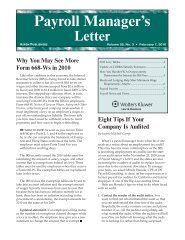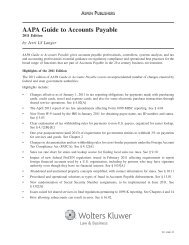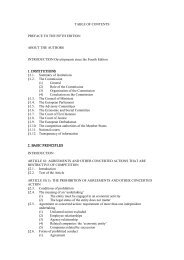Health Care Collector - Kluwer Law International
Health Care Collector - Kluwer Law International
Health Care Collector - Kluwer Law International
Create successful ePaper yourself
Turn your PDF publications into a flip-book with our unique Google optimized e-Paper software.
PAGE11<br />
work with patients to make sure they know how to use<br />
them. One important step in this process would be to<br />
ask about access to the Internet:<br />
• Does the patient have Internet access at home?<br />
• Is there someone who can help the patient learn<br />
how to use the Internet if the patient doesn’t<br />
already know?<br />
• Can the patient go to the library to get online?<br />
Other tools patients might use include videos<br />
they can borrow from the library for exercise or<br />
diet instruction rather than pay fees to join a class.<br />
Instruction in how to join an email support group<br />
can save a patient the expense of transportation to<br />
meetings while at the same time providing access to<br />
a community of individuals who share the patient’s<br />
concerns.<br />
Editor’s Note: If your offi ce or hospital has<br />
a Web site, advise patients about it. Help them get<br />
signed up so they can take advantage by asking questions<br />
or making payments online.<br />
Consider the Human Costs<br />
Everyone agrees that it is expensive being a<br />
patient. A recent study looked at patients’ nonmedical<br />
costs at three phases of cancer care. These costs<br />
included time spent traveling to and from care, waiting<br />
for appointments, and receiving consultation<br />
from providers. They totaled hundreds to thousands<br />
of dollars per year. By talking with your patients about<br />
these costs, you can help them find ways to reduce<br />
those costs and relieve part of the stress involved in<br />
getting good health care. ■<br />
Reader’s Resource<br />
William Shrank, MD, MSHS, is an instructor at<br />
Harvard Medical School and at the division of<br />
pharmacoepidemiology and pharmacoeconomics<br />
at Brigham and Women’s Hospital in Boston. You<br />
can reach him by email at wshrank@partners.org.<br />
Source: Article reprinted with permission from<br />
the author and On Call Magazine and published<br />
by Boston.com/Monster , a division of Boston Globe<br />
Media. On Call is available online at http://www.<br />
boston.com/jobs/health care/oncall.<br />
Collection Tips and News<br />
Fine Tune Your Payer Collections Strategy<br />
How well do you know your payers? Start by developing<br />
a profile of each payer and identifying how<br />
each payer’s process works. Then, check it against<br />
your employees’ procedures for working with that<br />
payer. You may find that your employees use<br />
the same procedure from one payer to the next.<br />
But one process does not fit all payers. First,<br />
assess what your staff currently knows about the<br />
payer. What information and phone numbers do<br />
they have? To begin, a payer profile should include<br />
the names and phone numbers of the key payer<br />
contact staff, including:<br />
• Customer service;<br />
• Customer service supervisor and manager;<br />
• Claims department;<br />
• Claims department supervisor and manager;<br />
• Mailroom supervisor;<br />
• Medical review manager;<br />
• Medical officer;<br />
• Legal counsel;<br />
• Compliance officer;<br />
• UR manager;<br />
• Appeals manager;<br />
• Provider rep; and<br />
• Provider rep manager.<br />
Tip: Find out how much authority each<br />
provider rep has to resolve claims issue. If<br />
reps have no authority, you can move on to<br />
the next level.<br />
Source: Judy Veazie, CPAM.<br />
HEALTH CARE COLLECTOR AUGUST 2010






